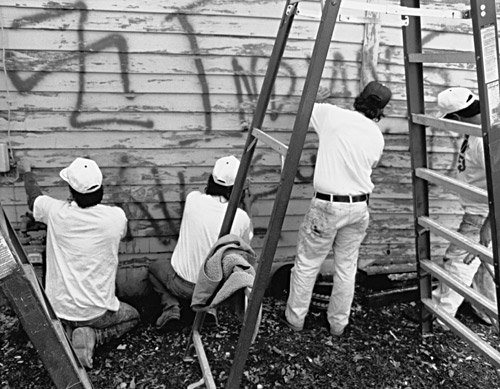Lessons from Billings, Montana
By Margaret MacDonald
Editor’s Note: In the early 1990s, white supremacists groups were growing bolder in their activities in Billings, MT. Hate literature began appearing around town and then members of the Native American and Jewish communities became the targets of a rash of hate crimes. Rather than resigning themselves to the growing climate of hate, a group of community members decided to organize and send a different message to their neighbors. Margaret MacDonald, a leader in the original Not In Our Town Movement in Billings, Montana, reflects on some of the guiding principles that helped shape the community’s creative and powerful responses, later captured by The Working Group in the documentary “Not In Our Town.”
The first principle was that we decided hate speech – graffiti, vandalism and flyers around town – should not be ignored simply because it came from “kids.” Of course, we did not know exactly where it came from, but many community leaders presumed it was, and also thought the best course would be to pretend it wasn’t happening. Fortunately, we had three things going in our favor – (1) a sophisticated statewide human rights organization that was on the cutting edge of countering this burgeoning movement, (2) strong faith community leaders who were willing to step up and play a leadership role in the community and articulate thoughtful, strong arguments for addressing these ideas proactively, and (3) a police chief who watched a similar situation unfold in his previous posting and learned the hard way that when communities tried to ignore this movement, they paid a price in escalating violence and ultimately tragedy.
 The second principle we realized was that the targeted communities of hate groups were going to be watching very closely to see how the rest of the town was responding. If the town is saying, “It’s not a big deal, it’s just kids acting out, don’t pay attention to them, that’s all they are seeking,” the message to the families who are being bullied and intimidated is that, “Your safety is unimportant.” If the town, on the other hand, says that what happens to the smallest minority, happens to us all; and we will not stand by and permit that to continue, the whole community is strengthened and relationships are built up. All kinds of wonderful and surprising fruits will come from stepping up to this issue.
The second principle we realized was that the targeted communities of hate groups were going to be watching very closely to see how the rest of the town was responding. If the town is saying, “It’s not a big deal, it’s just kids acting out, don’t pay attention to them, that’s all they are seeking,” the message to the families who are being bullied and intimidated is that, “Your safety is unimportant.” If the town, on the other hand, says that what happens to the smallest minority, happens to us all; and we will not stand by and permit that to continue, the whole community is strengthened and relationships are built up. All kinds of wonderful and surprising fruits will come from stepping up to this issue.The third principle we worked by was to focus the energy of the community not so much on the perpetrators, but rather on their targets and find significant ways to publicly stand with them. So at every step of harassment and intimidation, more support is manifest for those who are being targeted. That is not to say that if the perpetrators can be identified and brought to justice, they certainly should be. But the creative nonviolent “jujitsu” of making every action elicit even stronger support for the targets of hate undermines the impetus and the energy of the hate groups and their insidious message. It also creates inestimably valuable teaching moments in thousands of homes, classrooms, work places, churches, and other venues across the community.
Add new comment